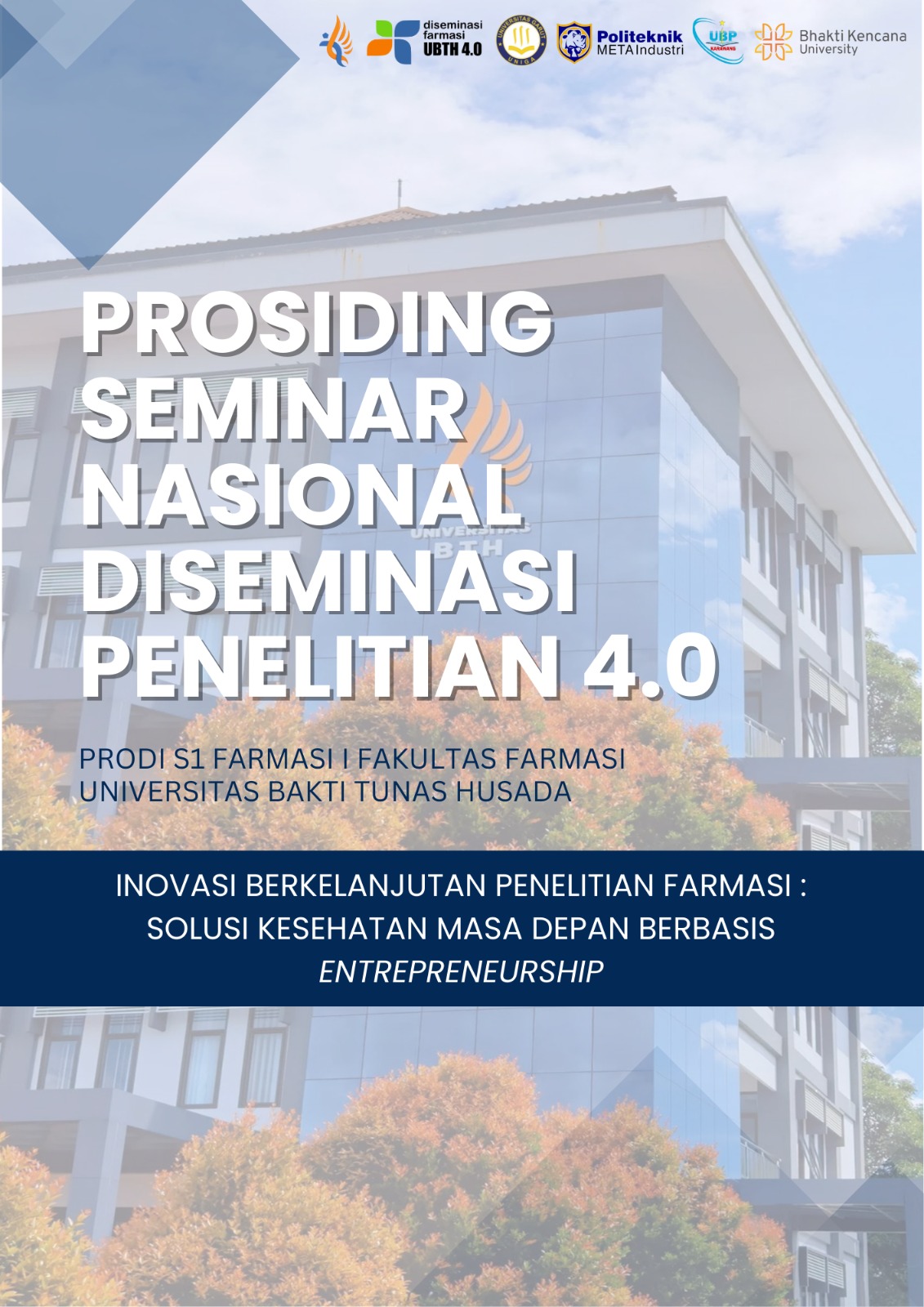Perbandingan Karakteristik Nanopartikel Kolagen dari Limbah Tulang Ikan Tongkol (Euthynnus affinis) dengan Menggunakan Ball Mill dan Magnetic Stirrer
Keywords:
tuna fish bones, collagen, nanoparticleAbstract
Tuna fish bones have a protein content of around 24-35%, which can be processed into collagen. Collagen from fish bones is classified as type I collagen, which contains large amounts of the amino acids glycine, alanine, proline, and hydroxyproline. Nano collagen is a form of collagen reduced to nanoparticle size that has rapid treatment capabilities to improve healing and cell growth. The method for making collagen nanoparticles uses two methods, namely, the top-down method using a ball mill and salting out using a magnetic stirrer. This study aims to compare the characteristics of collagen nanoparticles from tuna bone waste (Euthynnus affinis) made using a ball mill and a magnetic stirrer. Making nanoparticles using a magnetic stirrer with acetic acid solvent and salting out with ammonium hydroxide produces the smallest particle size, namely 528 nm with a polydispersity index of 0.4932 and a potential of -18.29 mV. In comparison, nanoparticles made using a ball mill have a particle size index of 542.3 nm. polydispersity 0.511 and potential -15.43 mV. Morphological analysis using SEM shows that collagen nanoparticles have a spherical or round and irregular shape. It can be concluded that making collagen nanoparticles using the magnetic stirrer method produces better characteristics than the ball mill method.
References
Abdassah, M. (2017). Nanopartikel dengan gelasi ionik. Jurnal Farmaka, 15(1), 45–52.
Agustin, R., Arta, D. R., & Nofita, R. (2023). Pengecilan Ukuran Partikel Dan Karakterisasi kolagen dari Kulit Ikan Gabus (Channa Striata) Dengan Metode Ball Milling. Jurnal Sains Farmasi & Klinis, 10(1),44. https://doi.org/10.25077/jsfk.10.1.44- 53.2023
Aleksandra Zieli ´nska 1, 2, , Filipa Carreiró 1, Ana M. Oliveira 1, Andreia Neves 1, B. P. 1, 3, D. N. V., 4, A. D., , Massimo Lucarini 4, P. E. 5, Amélia M. Silva 6, 7, & , Antonello Santini 8,* and Eliana B. Souto 1, 9. (2020). Polymeric Nanoparticles: Production, Characterization, Toxicology and Ecotoxicology. Molecules, 25, 3731.
Amirrah, I. N., Lokanathan, Y., Zulkiflee, I., Wee, M. F. M. R., Motta, A. , & Fauzi, M. B. (2022). A Comprehensive Review on Collagen Type I Development of Biomaterials for Tissue Engineering: From Biosynthesis to Bioscaffold. Biomedicines, 10(9).
https://doi.org/10.3390/biomedicines1009 2307
Darvish, D. M. (2022). Collagen fibril formation in vitro: From origin to opportunities. Materials Today Bio, 15(June), 100322. https://doi.org/10.1016/j.mtbio.2022.1003 22
Divya, K., & Jisha, M. S. (2018). Chitosan nanoparticles preparation and applications. Environmental Chemistry Letters, 16(1), 101–112. https://doi.org/10.1007/s10311-017- 0670-y
Helwig, N. E., Hong, S., & Hsiao-wecksler, E. T. (n.d.). Potensi Abu dari Tulang Ikan Tongkol Sebagai Adsorben Ion Mangan Dalam Larutan. 1(2), 1–9.
Hou, N., & Chen, B. (2023). Preparation of Nanoemulsions with Low-Molecular- Weight Collagen Peptides from Sturgeon Fish Skin and Evaluation of Anti-Diabetic and Wound-Healing Effects in Mice.
Juliantoni, Y., Hajrin, W., & Subaidah, W. A. (2020). Nanoparticle Formula Optimization of Juwet Seeds Extract (Syzygium cumini) using Simplex Lattice Design Method. Jurnal Biologi Tropis, 20(3), 416–422. https://doi.org/10.29303/jbt.v20i3.2124
Kusa, S. R., Naiu, A. S., & Yusuf, N. (2022). KARAKTERISTIK KOLAGEN KULIT TUNA SIRIP KUNING (Thunnus albacares ) PADA WAKTU HIDRO- EKSTRAKSI BERBEDA. Sinta 4, 107–116.
Lo, S., & Fauzi, M. B. (2021). Current update of collagen nanomaterials—fabrication, characterisation and its applications: A review. Pharmaceutics, 13(3), 1–18. https://doi.org/10.3390/pharmaceutics13 030316
Lohani, A., Verma, A., Joshi, H., Yadav, N., & Karki, N. (2018). Nanotechnology-Based Cosmeceuticals. 2014.
Mujiono, Qiram, I., & Rubiono, G. (2021). Pengaruh Penambahan Profil Pada Dinding Silinder Ball-Mill Terhadap Distribusi Massa Serbuk Batu Bata. V- MAC (Virtual of Mechanical Engineering Article), 6(2), 52–56. https://doi.org/10.36526/v-mac.v6i2.1517
Nining, N. (2020). Pemanfaatan Kolagen Laut dalam Sistem Penghantaran Obat. Majalah Farmasetika, 5(5), 245. https://doi.org/10.24198/mfarmasetika.v5i 5.28866
Nora Idawati; Intan Novita; Sy Irwan Nurdiansyah; Sukal Minsas; Sepridawati Siregar. (2022). IDENTIFIKASI KOLAGEN DARI CANGKANG BULU BABI ( Diadema setosum) ASAL PERAIRAN PULAU LEMUKUTAN. Marinade, 05(02), 136–141.
Romadhon, Yudhomenggolo Sastro Darmanto, R. A. K. (2019). The Difference Characteristicsof Collagen from Tilapia (Oreochromis niloticus ) Bone , Skin , and Scales. 22, 403–410.
Safithri, M., Tarman, K., Suptijah, P., & Novita Sagita, S. (2020). Karakteristik Kolagen Larut Asam Teripang Gama (Stichopus variegatus). Jurnal Pengolahan Hasil Perikanan Indonesia, 23(1), 166–177. https://doi.org/10.17844/jphpi.v23i1.3106 3
Septiansyah, E., Putra, O. A., Abshar, K., Jati, D. R., & Apriani, I. (2020). PEMANFAATAN TULANG IKAN TONGKOL (Euthynnusaffinis C) DARI LIMBAH HOME INDUSTRY ABON SEBAGAI TEPUNG. Jurnal Teknologi Lingkungan Lahan Basah, 8(2), 076. https://doi.org/10.26418/jtllb.v8i2.44169
Statistika. (2021). Produksi Perikanan Tangkap di Laut Menurut Komoditas Utama (Ton), 2019-2021. Badan Pusat Statistik.
Sudewi. (2020). Formulasi Sediaan Krim Menggunakan Kolagen Tulang Ikan Patin (Pangasius sp.) sebagai Anti Aging. Journal of Pharmaceutical and Health Research, 1(2), 27–31.
Trisnayanti, N. P. (2020). Metode sintesis nanopartikel. Universitas Indonesia, 3, 1–4.
Yanti, F., Dharmayanti, N., & Suryanti, S. (2022). Aktivitas Antioksidan Kolagen dari Kulit Ikan Patin (Pangasius sp.) dengan Enzim Bromelin Kasar Kulit Nanas (Ananas comosus L.). Jurnal Pengolahan Hasil Perikanan Indonesia, 25(1), 88–96. https://doi.org/10.17844/jphpi.v25i1.3673 1

